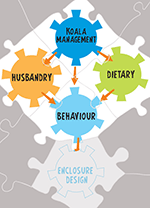The Koala Retreat program combines dietary and husbandry advice to ensure the optimal behavioural and wellbeing results in the koala. Our programs are custom designed to best suit your institution and the environment in which the koala lives in.
The natural environment of a koala can be influenced by a range of factors, including government policymakers and industry decision-making, direct human behaviours such as habitat exploitation, as well as pollution, bushfires, climate change and soil erosion.
Koala Retreat will offer your institution the opportunity to innovate in the 21st century, developing tighter and more adaptive guidelines that will allow the koala to thrive as the robust, independent and iconic species that it is.
Our programs seek to forge new understandings in the zoological industry and create greater awareness among the general public.
With proper planning, a long-term strategic vision, well-thought-out operational processes, a well-managed marketing plan and a highly skilled, passionate team with local knowledge, solid local transport, and access to plenty of accommodation providers, the koala will make enough of an income to grow the Australian economy, assist other industries, provide jobs, and support businesses.
The relationships between staff, their general disposition and attitude toward their job, and their daily manner has a huge impact on the koala’s psychological health. A toxic or negative work environment, where staff are disgruntled, angry or bitter, can lead to noticeable behavioural changes within a captive koala population.
That is why Koala Retreat is dedicated to understanding and transforming the culture in your organisation to ensure that each staff member is reaching their full potential, both individually, and part of a team. Overall company culture is a critical part of the overall development for a successful Koala Management Program, with a heavy focus on returning to traditional methods, and planning with purpose.
Koalas (Phascolarctos cinereus) are highly specialised, tree-dwelling marsupials. They feed on foliage, mainly Eucalyptus. The distribution of Eucalyptus species varies tremendously between (and within) different Australian states and koalas have evolved to utilise Eucalyptus trees as their main source of food. Koalas have been known to change their eating habitats, usually under stressful conditions to adapt to non-eucalyptus trees, such as Melaleucas, Acacia, conifers, Casuarina, Banksia, and Lophostemon.
There are over 600 different types of Eucalyptus, and koalas are known to eat only around ten percent of that figure. This ten percent is known as their basic food source, and within that basic source, only a small number are referred to as their preferred food trees. When harvested, not all trees will be at optimum palatability (TIP). “Tip” is the term for juvenile leaves at the top of a tree, which turn to yellow-reddish in colour. From time to time individual koalas may consume the foliage of other eucalyptus as well as non-eucalyptus species.
Koalas in captivity - when given the choice - are visibly motivated by juvenile leaves and appear to crave it in preference to mature leaves. Koalas have highly efficient digestive systems and therefore can handle a highly fibrous diet such as eucalyptus leaves with low nutrient levels.
Leaves can be viewed as consisting of two components – the contents of the cells and the walls that surround these cells. Cell contents are relatively easy to digest and contain most of the proteins and sugars and starch, but to gain access to the cell content, first the cell wall must be ruptured. Cell wall is difficult to digest and consists principally of complex carbohydrates such as cellulose. Young leaves contain proportionally more cell content than cell wall, and are an important source of energy.
In the wild, koalas have the capacity to move almost in a circular fashion around the native flora as the change of seasons takes place. The texture of leaves undergoes changes, and koalas can detect these changes with their sensitive sense of smell. By offering koalas a wide variety of species of leaves to eat, from different recorded sources, you build up important knowledge about their feeding behaviour and their personal characteristics.

